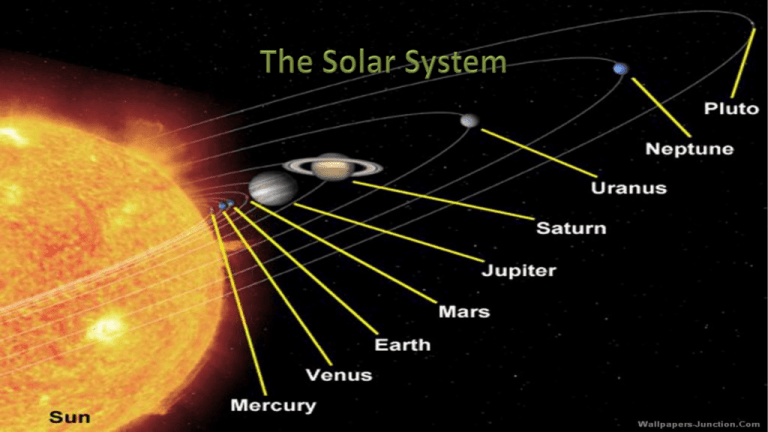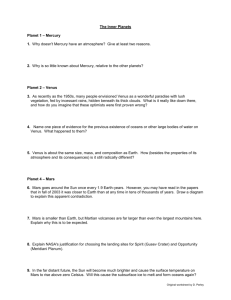The Sun - RIT Wiki
advertisement

The solar system consists of: The Sun Eight Planets Asteroids Comets Natural Satellites (moons) Meteorites Interplanetary Medium Solar Dust The Sun Heart of the Solar System 99.8 percent of the solar system's mass Exploding 100 billion tons of dynamite every second to match the energy produced by the Sun. (Credit: The satellite Solar and Heliospheric observatory, an international project by NASA and the European Space Agency) The sun was born roughly 4.6 billion years The Solar Nebula Active Nuclear Fuel Sun Reveals the Filamentary Nature of the Plasma. 2005. SPACE. Wikipedia. Web. "Solar System Exploration: : Planets." Solar System Exploration: : Planets. N.p., n.d. Web. 12 Mar. 2014. Mercury planet Mercury - closest and the smallest planet to the Sun of the eight planets. Is so close to the sun, that's why there is no atmosphere. Was discovered 5000 years ago and named from one of the Roman gods. It has a huge metallic core which is about 2,200 to 2,400 miles. "Mercury planet." Mercury planet image search results. 12 Mar. 2014 <http://gal1.piclab.us/key/mercury%2520planet>. Mercury What is the importance of this planet? From which conclusion, is called Mercury? Because what Mercury is so small? "Exploration of Mercury." Universe Today RSS. 12 Mar. 2014 <http://www.universetoday.com/35527/explor ation-of-mercury/>. VENUS The diameter of Venus is 12,092 km (only 650 km less than the Earth's) and its mass is 81.5% of the Earth's With a mean surface temperature of 735 K (462 °C; 863 °F), Venus is by far the hottest planet in the Solar System. Characteristics Venus is the second planet from the Sun. . It is named after the Roman goddess of love and beauty. Earth's "sister planet" Venus is always brighter than any star The greatest luminosity, apparent magnitude −4.9, occurs during crescent phase when it is near the Earth. Earth Earth, our home planet, is the only planet known to support life in our solar system. Earth was formed approximately 4.5 billion years ago. Earth Day Texas 2014. Photograph. Fair Park 1300 Robert B. Cullum Blvd. , Dallas, TX. EARTH The four seasons are a result of Earth's axis of rotation being tilted more than 23 degrees. Earth is the only planet not named after a god. Photo of Four Seasons Of Planet Earth. N.d. Photograph. N.p. By Marilna. JUPITER Radius Mass Surface Orbits Sun A complete orbit in about 12 earth years Jupiter Fifth planet Most massive Gas and liquid Moons and magnetic field 11x larger than the earth No life Saturn Radius: 58,232 km Mass: 95.16 Earth mass Surface area: 42.7 billion km² Distance from Sun: 1,433,000,000 km Position Size Name References "Solar System Exploration: Planets: Jupiter: Overview." Solar System Exploration: Planets: Jupiter: Overview. N.p., n.d. Web. 12 Mar. 2014. "Jupiter: Largest Planet of the Solar System." Space.com. N.p., n.d. Web. 12 Mar. 2014 "Jupiter." National Geographic. N.p., n.d. Web. 12 Mar. 2014. Jones, Barrie William. Discovering The Solar System. Chichester, West Sussex, England: John Wiley, 2007. eBook Collection (EBSCOhost). Web. 12 Mar. 2014 "Earth." L Facts, Pictures and Information. N.p., n.d. Web. 12 Mar. 2014. ^ Lakdawalla, Emily (21 September 2009), Venus Looks More Boring than You Think It Does, Planetary Society Blog (retrieved 4 December 2011) Lewis, John S. (2004). Physics and Chemistry of the Solar System(2nd ed.). Academic Press. p. 463 yons, Daniel T.; Saunders, R. Stephen; Griffith, Douglas G. (May–June 1995). "The Magellan Venus mapping mission: Aerobraking operations". Acta Astronautica 35 (9–11): 669–676 G. A. Landis, "Robotic Exploration of the Surface and Atmosphere of Venus", paper IAC-04Q.2.A.08, Acta Astronautica, Vol. 59, 7, 517–580 THANK YOU FOR YOUR ATTENTION Behar Fazliu Apoita Rexhepi Yvesa Husaj Drilon Derguti Armend Ademaj Veron Selmani Diar Kabashi








